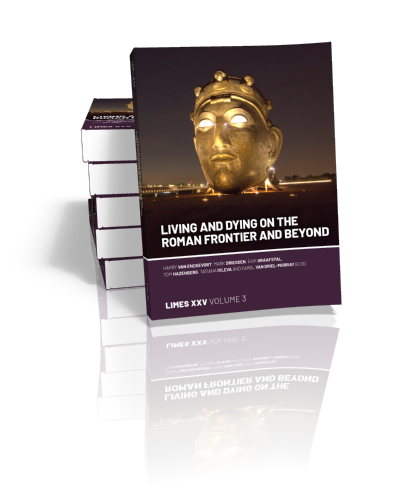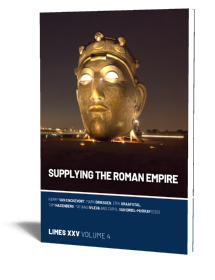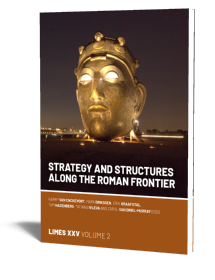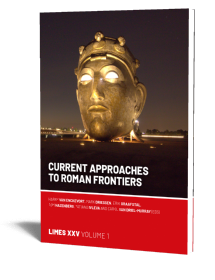Living and dying on the Roman Frontier and beyond (LIMES XXV volume 3)
Proceedings of the 25th International Congress of Roman Frontier Studies 3
Edited by Harry van Enckevort, Mark Driessen, Erik Graafstal, Tom Hazenberg, Tatiana Ivleva and Carol van Driel-Murray | 2024

Living and dying on the Roman Frontier and beyond (LIMES XXV volume 3)
Proceedings of the 25th International Congress of Roman Frontier Studies 3
Edited by Harry van Enckevort, Mark Driessen, Erik Graafstal, Tom Hazenberg, Tatiana Ivleva and Carol van Driel-Murray | 2024
Paperback ISBN: 9789464262810 | Hardback ISBN: 9789464262827 | Imprint: Sidestone Press | Format: 210x280mm | 458 pp. | Language: English | 22 illus. (bw) | 161 illus. (fc) | Keywords: archaeology; Roman Empire; Roman frontiers; limes; Roman army; childhood; propaganda; childhood; everyday life; mobility; military societies; religious convictions; funerary archaeology | download cover | DOI: 10.59641/1b090en
Read online or downloaded 2526 times
-
Digital & Online access
This is a full Open Access publication, click below to buy in print, browse, or download for free.
-
Buy via Sidestone (EU & UK)
-
Buy via our Distributors (WORLD)
For non-EU or UK destinations you can buy our books via our international distributors. Although prices may vary this will ensure speedy delivery and reduction in shipping costs or import tax. But you can also order with us directly via the module above.
UK international distributor
USA international distributor
-
Bookinfo
Paperback ISBN: 9789464262810 | Hardback ISBN: 9789464262827 | Imprint: Sidestone Press | Format: 210x280mm | 458 pp. | Language: English | 22 illus. (bw) | 161 illus. (fc) | Keywords: archaeology; Roman Empire; Roman frontiers; limes; Roman army; childhood; propaganda; childhood; everyday life; mobility; military societies; religious convictions; funerary archaeology | download cover | DOI: 10.59641/1b090en
Read online or downloaded 2526 times

We will plant a tree for each order containing a paperback or hardback book via OneTreePlanted.org.
This publication – Living and Dying on the Roman Frontiers and Beyond – is the third volume of the LIMES XXV’s congress proceedings and deals with a variety of themes, including the iconography of victory; aspects of frontier societies; mobility and the place of children; funerary archaeology; the significance of Roman imports beyond the frontiers. The proceedings are mostly arranged around the original sessions, creating coherent thematical collections that make the vast output more accessible to generalists and specialists alike.
Frontiers are zones, or lines, of contact and coercion, of exchange and exclusion. As such they often express some of the most typical elements of the socio-political spaces that are defined by them. Spanning some 6,000 km along rivers, mountain ranges, artificial barriers and fringes of semi-desert, the frontiers of the Roman empire offer a wide variety of avenues and topics for a very diverse community of scholars. They are the central subject of the International Congress of Roman Frontier Studies (or just Limes Congress after the Latin word for ‘border’), organised every three years since 1949. This four-volume publication contains most of the papers presented at the 25th edition which was hosted by the municipality of Nijmegen in August 2022.
Find all four volumes of the LIMES XXV Proceedings here.
About the editors
Dr. Harry van Enckevort has been researching the (Roman) past of Nijmegen as an archaeologist since 1990. The first years he worked for the State Service for Archaeological Investigations in the Netherlands (ROB), then for the municipality of Nijmegen, and since the end of 2022 as an independent researcher.
Dr.ir. Mark Driessen, Assistant Professor at the Faculty of Archaeology – Leiden University (2011-now); Udhruh Archaeological Project (2011-now).
Erik P. Graafstal (MA), Municipal archaeologist and Director of Museum Hoge Woerd, Utrecht.
Tom Hazenberg (MA), independent archeologist for Hazenberg Archeologie & Coordinator Research and Preservation for the Dutch Limes Association; Project Restoration Collection Roman Ships of Zwammerdam and development of the National Roman Maritime Museum at Museumpark Archeon (2010 – now).
Dr. Tatiana Ivleva is Visiting Research Fellow at Newcastle University (UK).
Dr. Carol van Driel-Murray, Formerly lecturer Provincial Roman Archaeology, Faculty of Archaeology, University of Leiden (retired).
Preface
Part 1. Tales of Glory. Narratives of Roman Victory
Narratives of Roman victory between Imperial propaganda and war crimes
Martina Meyr and Christof Flügel
Das sogenannte Ubiermonument in Köln. Versuch einer Deutung
Tilmann Bechert
Commemorating the dead in ancient Rome and modern Europe
David J. Breeze
The Vynen monument and commemorating a greater victory. Flavian propaganda and reconstruction along the limes
Michael den Hartog
Visions of victory in Roman Dacia
Monica Gui
Mere propaganda? Victoria and Mars representations and inscriptions on the Upper German-Raetian Limes
Martin Kemkes
Le programme iconographique peint de Deir el-Atrash. Contrôle romain, protection et présence militaire dans le désert Oriental
Julie Marchand and Joachim Le Bomin
My face and the wolf song. A Roman facemask and a ‘draco’ from Carnuntum
Eva Steigberger
Römische Staats- und Siegesdenkmäler in den Provinzen
Kai M. Töpfer
Part 2. Home away from home. Roman frontiers as movers and mixers of people
Evidence for child migration at Vindolanda on the northern frontier of Roman Britain. An osteobiography of a clandestine burial
Trudi J. Buck
I am going on a trip, what am I going to pack? A comparative approach to the pottery of Batavians at home and abroad
Cristina Crizbasan and Roderick C.A. Geerts
Mainz-Mogontiacum, ein ethnischer Schmelzpunkt an der Rheingrenze des Imperium Romanum im 1. Jahrhundert n. Chr.
Michael Johannes Klein
Soldiers, slaves, priests, administrative servants(?). Persons with Greek/oriental names in Rhaetia
Julia Kopf
Challenges for auxilia veterans in going home
Jared H. Kreiner
Ex toto Orbe Romano. Ethnical diversity at the western frontier of Roman Dacia
Eduard Nemeth
Part 3. Childhood on the Roman frontiers
Gendered futures. Children’s lives remembered on Rome’s northern frontiers
Maureen Carroll
Vulnerable victims. ‘Barbarian’ captive children in Roman Imperial conflict iconography
Kelsey Shawn Madden
Onomastics, children and identity on Roman military diplomas
Alexander Meyer and Elizabeth M. Greene
Part 4. Everyday life in the vicinity of the forts
Introduction to the session ‘The military vicus. Everyday life in the vicinity of the forts’
Julia P. Chorus and Monica K. Dütting
In the hinterland of the Roman fortress at Novae. A new contribution to the rural settlement pattern in Moesia inferior
Petya A. Andreeva
The prison in the fortress of Apulum (Alba Iulia)
George Cupcea
Leisure facilities in the Tingitanian frontier. The baths in the roman castellum of Tamuda (Tetouan, Morocco)
José A. Expósito, Darío Bernal-Casasola and Tarik Moujoud
The integration of public baths into post-military colonia and civitas capitals in Roman Britain
Amanda A. Hardman
From Caesar to Late Antiquity. Roman settlement in the vicinity of the Hermeskeil fortress
Sabine Hornung, Lars Blöck, Marvin Seferi, Patrick Mertl and Arno Braun
Spuma Batava. Experimental research into a Germanic fad in 1st century Rome
Hans D.J. Huisman and Dorothee M. Olthof
One thing leads to another. Settlement development in the Stein-Lauriacum/Enns region (Austria)
Barbara Kainrath and Eva Thysell
The Arnsburg tumulus and the imagined underworld. Bathing and hunting in the meadows of the river Wetter
Julia M. Koch
From Imperial guardians to local patriots. The defenders of Novae (Moesia inferior) in Late Antiquity and their relationship to state, church and neighborhood
Martin Lemke
Game as cultural bridging. The case of the Batavians of Vindolanda
Alessandro Pace
Alchester. Life in a fortress of the AD 40’s
Eberhard W. Sauer
How were milestone texts transmitted to the stonecutters?
Dé C. Steures
The Birdoswald Extra-Mural Settlement Project
Tony Wilmott and Ian Haynes
Part 5. Cult and religious practices
Sub-Roman and post-Roman Christianity on Hadrian’s Wall. The remarkable new evidence from Vindolanda
Marta Alberti and Andrew Robin Birley
Merkur, Vulkan, Neptun und Herkules. Die Götter der Arbeitswelt und ihre Verehrung im Vicus
Dorit C. Engster
The marble bust of Mithraic tauroctony from Olbia Pontica
Roman Kozlenko
Of pigs and gods. An altar to Jupiter Heliopolitanus from Siscia (Sisak) revisited
Ljubica Perinić and Anton Ye. Baryshnikov
A puzzling votive inscription by a decurion of the cohors I Belgarum
Ivan Radman-Livaja
Principia or monasteries? Two fortified basilicas in the North African frontier zone
Alan Rushworth
Ein großes lararium… oder ein kleiner Tempel. Ein privater Schrein im Nordvicus von Krefeld-Gellep
Eric Sponville
Part 6. Speaking of the dead. Funerary customs and grave goods
Across Rome’s Southern Frontier. The Meroitic cemetery at Faras in Sudanese Nubia
Henry C. Bishop-Wright
A group of unusual burials under the CUT by-pass, Xanten
Clive Bridger
Relecture chronologique de la tombe des enfants du triérarque Domitianus à Boulogne-sur-Mer
Julie Flahaut, Olivier Blamangin, Alexia Morel, Angélique Demon, Christine Hoët-Van Cauwenberghe, Aurore Louis and Annick Thuet
The rural burial landscape in the northern hinterland of Roman Nijmegen
Joep Hendriks
Life and death at the Danube Limes. The cemeteries of Lauriacum/Enns (Austria)
Lisa Huber, Felix Lang, Maria Marschler, Andrea Stadlmayr and Stefan Traxler
Challenging late antique chronology. Graves as continuity indicators along the Rhine frontier of Germania prima
Rebecca Nashan
Buried with the dead. Grave goods from twelve Roman cemeteries in the Dutch eastern river area
W. Frederique Reigersman-van Lidth de Jeude
Roman funerary archaeology in Slovenia. The known, the new, and the missing
Kaja Stemberger Flegar
Deviant burials in late antique Atuatuca Tungrorum (Tongeren, Belgium)
Steven Vandewal
Dying outside the gates. The Brooklyn House, Norton, Yorkshire, bustum burial and busta in Roman Britain
Pete Wilson
Part 7. Revisiting Roman imports beyond the frontier. Investigating processes of movement
Roman-barbarian interaction. Revisiting Roman imports beyond the frontier; investigating processes of movement. Introductory remarks
Thomas Schierl, Fraser Hunter and Thomas Grane
Luxury, resources, or both? Roman objects in Germanic settlements on the example of Ostwestfalen-Lippe
Hannes Buchmann
Asking ‘Why’. Seeking indigenous motivations behind the movement of Roman material into Ireland
Karen Murad
Abstract:
This publication – Living and Dying on the Roman Frontiers and Beyond – is the third volume of the LIMES XXV’s congress proceedings and deals with a variety of themes, including the iconography of victory; aspects of frontier societies; mobility and the place of children; funerary archaeology; the significance of Roman imports beyond the frontiers. The proceedings are mostly arranged around the original sessions, creating coherent thematical collections that make the vast output more accessible to generalists and specialists alike.
Frontiers are zones, or lines, of contact and coercion, of exchange and exclusion. As such they often express some of the most typical elements of the socio-political spaces that are defined by them. Spanning some 6,000 km along rivers, mountain ranges, artificial barriers and fringes of semi-desert, the frontiers of the Roman empire offer a wide variety of avenues and topics for a very diverse community of scholars. They are the central subject of the International Congress of Roman Frontier Studies (or just Limes Congress after the Latin word for ‘border’), organised every three years since 1949. This four-volume publication contains most of the papers presented at the 25th edition which was hosted by the municipality of Nijmegen in August 2022.
Find all four volumes of the LIMES XXV Proceedings here.
About the editors
Dr. Harry van Enckevort has been researching the (Roman) past of Nijmegen as an archaeologist since 1990. The first years he worked for the State Service for Archaeological Investigations in the Netherlands (ROB), then for the municipality of Nijmegen, and since the end of 2022 as an independent researcher.
Dr.ir. Mark Driessen, Assistant Professor at the Faculty of Archaeology – Leiden University (2011-now); Udhruh Archaeological Project (2011-now).
Erik P. Graafstal (MA), Municipal archaeologist and Director of Museum Hoge Woerd, Utrecht.
Tom Hazenberg (MA), independent archeologist for Hazenberg Archeologie & Coordinator Research and Preservation for the Dutch Limes Association; Project Restoration Collection Roman Ships of Zwammerdam and development of the National Roman Maritime Museum at Museumpark Archeon (2010 – now).
Dr. Tatiana Ivleva is Visiting Research Fellow at Newcastle University (UK).
Dr. Carol van Driel-Murray, Formerly lecturer Provincial Roman Archaeology, Faculty of Archaeology, University of Leiden (retired).
Contents
Preface
Part 1. Tales of Glory. Narratives of Roman Victory
Narratives of Roman victory between Imperial propaganda and war crimes
Martina Meyr and Christof Flügel
Das sogenannte Ubiermonument in Köln. Versuch einer Deutung
Tilmann Bechert
Commemorating the dead in ancient Rome and modern Europe
David J. Breeze
The Vynen monument and commemorating a greater victory. Flavian propaganda and reconstruction along the limes
Michael den Hartog
Visions of victory in Roman Dacia
Monica Gui
Mere propaganda? Victoria and Mars representations and inscriptions on the Upper German-Raetian Limes
Martin Kemkes
Le programme iconographique peint de Deir el-Atrash. Contrôle romain, protection et présence militaire dans le désert Oriental
Julie Marchand and Joachim Le Bomin
My face and the wolf song. A Roman facemask and a ‘draco’ from Carnuntum
Eva Steigberger
Römische Staats- und Siegesdenkmäler in den Provinzen
Kai M. Töpfer
Part 2. Home away from home. Roman frontiers as movers and mixers of people
Evidence for child migration at Vindolanda on the northern frontier of Roman Britain. An osteobiography of a clandestine burial
Trudi J. Buck
I am going on a trip, what am I going to pack? A comparative approach to the pottery of Batavians at home and abroad
Cristina Crizbasan and Roderick C.A. Geerts
Mainz-Mogontiacum, ein ethnischer Schmelzpunkt an der Rheingrenze des Imperium Romanum im 1. Jahrhundert n. Chr.
Michael Johannes Klein
Soldiers, slaves, priests, administrative servants(?). Persons with Greek/oriental names in Rhaetia
Julia Kopf
Challenges for auxilia veterans in going home
Jared H. Kreiner
Ex toto Orbe Romano. Ethnical diversity at the western frontier of Roman Dacia
Eduard Nemeth
Part 3. Childhood on the Roman frontiers
Gendered futures. Children’s lives remembered on Rome’s northern frontiers
Maureen Carroll
Vulnerable victims. ‘Barbarian’ captive children in Roman Imperial conflict iconography
Kelsey Shawn Madden
Onomastics, children and identity on Roman military diplomas
Alexander Meyer and Elizabeth M. Greene
Part 4. Everyday life in the vicinity of the forts
Introduction to the session ‘The military vicus. Everyday life in the vicinity of the forts’
Julia P. Chorus and Monica K. Dütting
In the hinterland of the Roman fortress at Novae. A new contribution to the rural settlement pattern in Moesia inferior
Petya A. Andreeva
The prison in the fortress of Apulum (Alba Iulia)
George Cupcea
Leisure facilities in the Tingitanian frontier. The baths in the roman castellum of Tamuda (Tetouan, Morocco)
José A. Expósito, Darío Bernal-Casasola and Tarik Moujoud
The integration of public baths into post-military colonia and civitas capitals in Roman Britain
Amanda A. Hardman
From Caesar to Late Antiquity. Roman settlement in the vicinity of the Hermeskeil fortress
Sabine Hornung, Lars Blöck, Marvin Seferi, Patrick Mertl and Arno Braun
Spuma Batava. Experimental research into a Germanic fad in 1st century Rome
Hans D.J. Huisman and Dorothee M. Olthof
One thing leads to another. Settlement development in the Stein-Lauriacum/Enns region (Austria)
Barbara Kainrath and Eva Thysell
The Arnsburg tumulus and the imagined underworld. Bathing and hunting in the meadows of the river Wetter
Julia M. Koch
From Imperial guardians to local patriots. The defenders of Novae (Moesia inferior) in Late Antiquity and their relationship to state, church and neighborhood
Martin Lemke
Game as cultural bridging. The case of the Batavians of Vindolanda
Alessandro Pace
Alchester. Life in a fortress of the AD 40’s
Eberhard W. Sauer
How were milestone texts transmitted to the stonecutters?
Dé C. Steures
The Birdoswald Extra-Mural Settlement Project
Tony Wilmott and Ian Haynes
Part 5. Cult and religious practices
Sub-Roman and post-Roman Christianity on Hadrian’s Wall. The remarkable new evidence from Vindolanda
Marta Alberti and Andrew Robin Birley
Merkur, Vulkan, Neptun und Herkules. Die Götter der Arbeitswelt und ihre Verehrung im Vicus
Dorit C. Engster
The marble bust of Mithraic tauroctony from Olbia Pontica
Roman Kozlenko
Of pigs and gods. An altar to Jupiter Heliopolitanus from Siscia (Sisak) revisited
Ljubica Perinić and Anton Ye. Baryshnikov
A puzzling votive inscription by a decurion of the cohors I Belgarum
Ivan Radman-Livaja
Principia or monasteries? Two fortified basilicas in the North African frontier zone
Alan Rushworth
Ein großes lararium… oder ein kleiner Tempel. Ein privater Schrein im Nordvicus von Krefeld-Gellep
Eric Sponville
Part 6. Speaking of the dead. Funerary customs and grave goods
Across Rome’s Southern Frontier. The Meroitic cemetery at Faras in Sudanese Nubia
Henry C. Bishop-Wright
A group of unusual burials under the CUT by-pass, Xanten
Clive Bridger
Relecture chronologique de la tombe des enfants du triérarque Domitianus à Boulogne-sur-Mer
Julie Flahaut, Olivier Blamangin, Alexia Morel, Angélique Demon, Christine Hoët-Van Cauwenberghe, Aurore Louis and Annick Thuet
The rural burial landscape in the northern hinterland of Roman Nijmegen
Joep Hendriks
Life and death at the Danube Limes. The cemeteries of Lauriacum/Enns (Austria)
Lisa Huber, Felix Lang, Maria Marschler, Andrea Stadlmayr and Stefan Traxler
Challenging late antique chronology. Graves as continuity indicators along the Rhine frontier of Germania prima
Rebecca Nashan
Buried with the dead. Grave goods from twelve Roman cemeteries in the Dutch eastern river area
W. Frederique Reigersman-van Lidth de Jeude
Roman funerary archaeology in Slovenia. The known, the new, and the missing
Kaja Stemberger Flegar
Deviant burials in late antique Atuatuca Tungrorum (Tongeren, Belgium)
Steven Vandewal
Dying outside the gates. The Brooklyn House, Norton, Yorkshire, bustum burial and busta in Roman Britain
Pete Wilson
Part 7. Revisiting Roman imports beyond the frontier. Investigating processes of movement
Roman-barbarian interaction. Revisiting Roman imports beyond the frontier; investigating processes of movement. Introductory remarks
Thomas Schierl, Fraser Hunter and Thomas Grane
Luxury, resources, or both? Roman objects in Germanic settlements on the example of Ostwestfalen-Lippe
Hannes Buchmann
Asking ‘Why’. Seeking indigenous motivations behind the movement of Roman material into Ireland
Karen Murad
-
Digital & Online access
This is a full Open Access publication, click below to buy in print, browse, or download for free.
-
Buy via Sidestone (EU & UK)
-
Buy via our Distributors (WORLD)
For non-EU or UK destinations you can buy our books via our international distributors. Although prices may vary this will ensure speedy delivery and reduction in shipping costs or import tax. But you can also order with us directly via the module above.
UK international distributor
USA international distributor
- Browse all books by subject
-
Search all books

We will plant a tree for each order containing a paperback or hardback book via OneTreePlanted.org.
You might also like:
© 2025 Sidestone Press KvK nr. 28114891 Privacy policy Sidestone Newsletter Terms and Conditions (Dutch)








